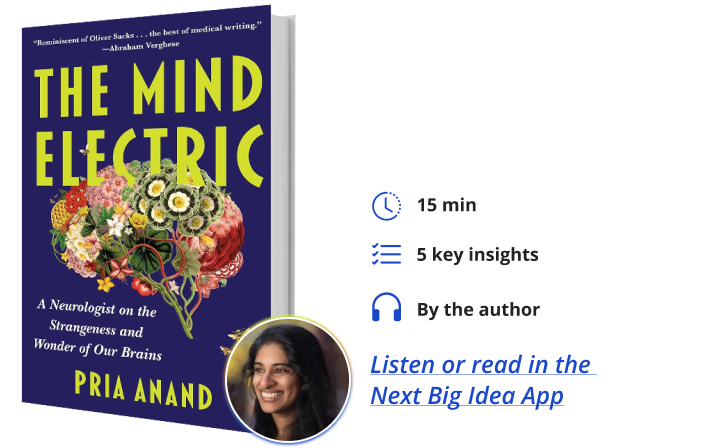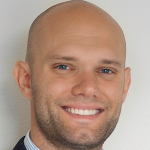Pria Anand is a neurologist at the Boston Medical Center and an Assistant Professor at the Boston University School of Medicine. She trained in neurology, neuroinfectious diseases, and neuroimmunology at Johns Hopkins Hospital and Massachusetts General Hospital.
What’s the big idea?
A complex relationship exists between culture, illness, stories, and the brain. To make sense of neurologic illnesses and symptoms, we craft narratives about the gray areas we have yet to—and may never fully—understand. Our brains defy binary classification. There is a great expanse between health and illness, which storytelling can help us analyze.
Below, Pria shares five key insights from her new book, The Mind Electric: A Neurologist on the Strangeness and Wonder of Our Brains. Listen to the audio version—read by Pria herself—below, or in the Next Big Idea App.

1. Our brains are built to tell stories.
Stories are how we make sense of the world. Our hunger for narrative is so deeply hardwired into our brains that, even when someone experiences a devastating brain injury and loses some essential brain function (such as their ability to form memories), their capacity to tell stories often not only survives the injury but also surges.
A remarkable example of this is the neurological symptom of confabulation, which occurs when our brains construct elaborate, imagined stories beyond our conscious control and even beyond our awareness. I’ve cared for patients who have suffered amnesia (as a result of a longstanding vitamin deficiency or a brain infection) who lost part of their life history as a consequence of their illness. To compensate for this profound and devastating loss, their brains confabulated new life stories to fill in the gaps.
2. People and communities often explain neurological illnesses through fables and myths.
One example of this is the folklore that exists around sleep paralysis, which often happens when someone is either falling asleep or waking up. When someone experiences sleep paralysis, they find themselves unable to move, and they often see images from their dreams, even though they’re wide awake. People who have experienced sleep paralysis describe imagined sounds, the sensation of flying from their beds, the inkling of a shadowy figure just beyond their line of sight, or the weight of a creature seated on their chest.
“Nearly every cultural tradition has a fable or a myth to explain the experience of sleep paralysis.”
Sleep paralysis is shockingly common—something like one in ten people will experience it at some point—and as a result, nearly every cultural tradition has a fable or a myth to explain the experience of sleep paralysis.
There are hundreds of words for sleep paralysis. In Japanese, it is kanashibari, a spell cast by a specter or a sorcerer; in Khmer, it is khmaoch sângkât, the ghost that pushes you down; and in Albanian, it is makthi, a shadowy man in a golden hat who offers exhausted women the relief of stillness.
3. Doctors are not immune to the desire to tell stories about illness.
Medical students are taught to imagine a binary: doctor and patient, science and faith, objective truth and superstitious fallacy, us and them. Morning rounds in hospitals are an exercise in telling and retelling patients’ stories in a way that explains their illnesses, cloaked in the sense of objectivity offered by a white coat. But the stories told on these rounds are just as prone to false truths as the reports of an amnesia patient. They are subconsciously shaped by our priors, our communities, and our own narratives.
In writing this book, I spent time reading medical texts that were decades or even centuries old. In those texts, there are so many similarities between the ways that medicine might make sense of a disease that is newly discovered or still in some way mysterious, and the way communities and patients do the same. We are all contending with the devastation of illness using the limited tools we have at our disposal. Chief among these tools is our ability to tell stories.
4. Neurological symptoms have a way of seeping into art and literature.
Fyodor Dostoyevsky suffered from epilepsy. He experienced seizures, always preceded by a dreamy aura of elation. He wrote his own epilepsy into his novels, from The Brothers Karamazov to The Idiot. However, the relationship goes both ways: just as neurological illnesses can inform our art, art can also inform our understanding of both illness and the brain.
Much of what we now know about the organization of the brain comes from art, specifically from the drawings of the nineteenth-century Spanish neuroscientist Santiago Ramon y Cajal. He was the son of a village surgeon, and although his father wanted him to be a doctor, Ramon y Cajal identified first as an artist. His father would take him to burial grounds to dig up corpses from graves with expired leases to use for anatomical studies. Ramon y Cajal would sketch the skeletons, fascinated by the ways a body could be more than the sum of its parts. He did eventually become a doctor, but he kept drawing, shifting his eye to what he called “the butterflies of the soul”—the minute structures of our brains and spinal cords. His drawings of the nervous system are strange and fantastical, revealing the ways our brains are an entire universe, filled with feathery butterfly wings and tangled gardens, with branching trees and yearning fungal hyphae, labyrinthine coral, and drifting seaweed, as well as constellations and alien terrain.
“Much of what we now know about the organization of the brain comes from art.”
Where other scientists saw only chaos, Ramon y Cajal saw order. He realized that the tangled gardens he saw under his microscope were networks of individual neurons, each beckoning to the next across the minute cleft of a synapse, and it was this revelation—the “neuron doctrine,” born of his artist’s eye—that won him the Nobel Prize.
5. Even the strangest neurological symptoms can tell us something essential.
We imagine that there’s some sort of binary between healthy brains and failing ones, when in reality, the functions of our bodies cannot be so easily or neatly categorized. There is a vast gray area that stretches between wellness and illness.
Neurological symptoms can reveal universal truths about the human experience—from language, to perception, to consciousness. The Mind Electric is about the stories we tell about our brains, and the stories our brains tell us, to make sense of that gray area.
Enjoy our full library of Book Bites—read by the authors!—in the Next Big Idea App:






























